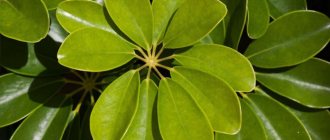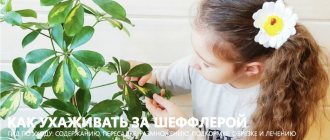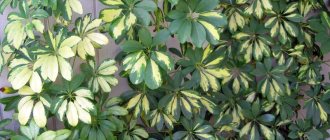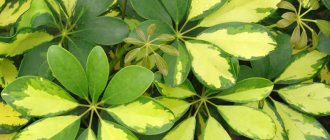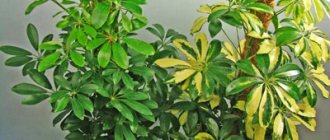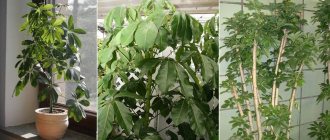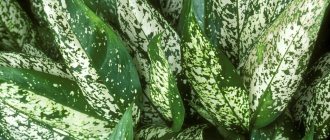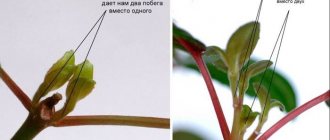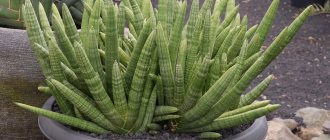Schefflera elegantissima 'Bianca' (lat. Schefflera elegantissima 'Bianca') is a beautiful shrub plant. It comes from New Caledonia, a group of islands in the South Pacific Ocean. Flowers are rare on this green houseplant, but it has beautiful leaves.
Schefflera elegantissima "Bianca" is considered to be quite easy to care for. However, if not properly cared for, it can shed its leaves. This is one of the mildly toxic green plants, so it is not suitable for families with small children and/or pets. Schefflera elegantissima can cause problems with the gastrointestinal tract, irritation of the skin and mucous membranes.
Description
Schefflera (or Schefflera) is native to many countries with tropical climates. In nature, it grows in the form of a tree or shrub. There are species that reach a height of forty meters. These species are not suitable for indoor breeding. Many specimens in nature have more modest sizes, reaching two meters. In indoor conditions, the plant can reach one and a half meters. Therefore, the plant can be more often found in spacious halls, offices, and winter gardens. If space allows, then Schefflera can be successfully grown in an apartment, you just need to take into account its rapid growth.
It belongs to the Araliaceae family, and about 400 species grow in nature. The plant got its name from the name of the famous botanist Jacob Christian Scheffler from Germany. It is characterized by umbrella-shaped leaves, consisting of several dissected lobes. The number of lobes on a leaf ranges from 4 to 12, depending on the variety. The leaves are located on long petioles.
In nature, the plant blooms with inconspicuous small white flowers collected in an umbrella. It is not possible to achieve schefflera flowering indoors, but this does not upset flower growers. Because decorative leaves more than compensate for the lack of flowers.
Benefits and harms
“Schefflera” produces the most positive effect on a person. It is believed that this plant absorbs all negative emotions, thereby freeing a person from anxiety and worries. Therefore, it is recommended to place “Schefflera” in the bedroom or recreation area.
Schefflera is an excellent natural moisturizer and cleanser. It affects the indoor air in such a way as to maintain an optimal microclimate and ecology.
"Schefflera" is shrouded in various superstitions. For example, if you give “Scheffler Bianca” to newlyweds, then by the state of growth of the bush you can determine how quickly to expect an addition to the family.
Important! We must not forget that Schefflera is a poisonous plant and can cause dermatitis.
Decorating your home with exotic plants has long been in fashion. Today, leading designers bring their ideas to life using plants such as Schefflera. Any beauty requires care. Only a plant that feels comfortable will look luxurious and add coziness to your home environment.
Types and varieties
The following types are used in indoor floriculture:
- eight leaf;
- radiate;
- tree-like;
- palmate.
Based on these species, breeders have developed new varieties of shefflera, which we will consider a little below.
Eight leaf
The plant got its name from the number of leaf blades, which ranges from eight to twelve. The leaves are lanceolate, pointed at the apex. Their length reaches 30-40 centimeters, and their width is about ten. The leathery leaves have several shades of green, and the veins on them are light cream.
Radifolia
Due to the shape of the leaf plate, it is also called star-leaved. You can recognize it by the number of leaves extending from the red-brown petiole. The sixteen leaves are ovoid at first. As the plant grows, they become longer, but remain blunt at the ends. Their length is fifteen centimeters and their width is five. The bright green leaves have a shiny leathery surface and light veins. This species is the most popular among gardeners. It is necessary to note the rapid growth of Schefflera radiata. Based on this species, varieties with yellow-green and golden-yellow leaf blades have been bred.
Tree-like
The plant is a tree that grows up to 1.2 m, with shoots extending from a straight trunk. This species is native to Southeast Asia. The number of leaves located on long petioles ranges from seven to sixteen. The leaves, which are up to fifteen centimeters long, reach eight centimeters in width. The size and shade of the leaves may vary depending on the variety.
Palmate
The homeland of palmate schefflera is New Zealand. In its homeland, the tree grows up to eight meters and resembles a palm tree. Eight ellipsoid-shaped leaves are on long petioles reaching twenty centimeters. The length of the leaves ranges from fifteen to thirty centimeters. It differs from the radiate species in its compactness.
This may be interesting: Nerthera (Coral berry) - home care
Janine
Schefflera Janine stands out for its variegated foliage. Light dots and streaks are scattered on the dark green background of the leaves. This variety is distinguished by the fact that it tolerates shading well and does not lose its variegated color.
Nora
The Nora variety is variegated. Narrow green leaves are covered with yellow specks. The edge of the leaves is framed with teeth. Schefflera Nora is distinguished by its unpretentiousness and lush crown.
Gold Capella
The variety was bred on the basis of the tree-like Schefflera. The tree has a lush crown with bright green leaves covered with golden spots.
Gerda
The Gerda variety prefers diffused light, moisture and fertile soil. The leaves of the plant are variegated, yellow-green in color. The height of the plant depends on the conditions of detention, and varies from 0.5 to 2.5 meters.
Luzeana
The Luzeana variety is distinguished by openwork leaves with yellow-green streaks. Shiny leathery plates add additional decorativeness.
Bianca
Plants of the Bianchi variety have short leaves, the length of which does not exceed eight centimeters. The leaf blade has denticles along the edge, covered with a white border. Beige spots are visible at the base of the leaves. The variety is decorative due to the shape and color of the leaves.
Custer
This variety, bred by breeders, is more suitable than others for growing in our apartments. The plant does not grow more than 120 centimeters. Its leathery, dark green leaves are medium in size.
A transparent relative of the common Scheffler
Most flower growers know Schefflera eleganta under the old name - Dizygotheca elegantissima and the popular nickname of false castor bean. There are many plants in the Scheffler genus that are loved by gardeners all over the world and firmly hold their positions in the ranking of large indoor giants. But shefflers are classic and popular - the plants are massive, and, although quite beautiful, they are still not original. But one unique species from this genus seems no less, perhaps, than an exceptional exotic. Schefflera elegantissima is a unique plant in terms of silhouettes, influence on the interior, and character.
This is one of the most elegant large-sized indoor crops. Despite the fact that shefflera bushes can reach one and a half meters and are quite voluminous, it seems weightless, transparent and devoid of the unpleasant ability of its fellows to visually reduce space and suppress the environment. The airiness of shefflera acts quite the opposite; it gives the rooms a feeling of freedom and additional space. The plant seems to compensate for heavy and massive objects.
But the main thing about the elegant sheffler is its ultra-modern, unusual, graphic and slightly defiant appearance. This plant is for modern interiors with their play of colors, textures and textures, for the environment in which such a graphic plant can be appreciated.
Tall stems, upright, slender, covered with spots, form an airy tree. Thin, densely branched shoots of Schefflera are difficult to distinguish from its leaves from a distance; narrow lanceolate leaves with a serrated, coarsely toothed edge and up to 40 cm long and less than 1 cm wide, folded into 5-10 pieces. into palmately compound leaves; but such a structure is difficult to assess both because of the thinness of the lobes themselves and because of the long petioles (up to 40 cm). The leaves on the shoots are arranged alternately. The older the plant, the less pronounced the palmate shape of the leaves and the more chaotic their structure.
The graceful Schefflera, unlike its fellows, cannot boast of a large palette of colors. This indoor plant has leaves that are colored only in a rich dark green color, which seems almost dark when placed opposite a window in the interior. The plant pleasantly surprises with the bronze color of its young leaves, on which the scarlet midrib stands out clearly.
In indoor conditions, Schefflera most graceful does not bloom, and in greenhouses there is not often an opportunity to admire the apical umbrellas of inflorescences.
On sale you can find both the base plant and the three most popular varieties of Schefflera graceful:
- 'Castor' - with smaller and wider lobes of three-fingered leaves;
- 'Bianca' - light green variety with a cream border along the edge of shortened wide lobes;
- 'Gemini' - with ovate leaves of a dark color with a reddish vein.
But these plants are still less graceful than the ordinary Schefflera elegantissima.
Schefflera elegantissima. © floradania
Rules for caring for shefflera at home
Schefflera is unpretentious when grown indoors. But there are simple maintenance rules that will ensure the beauty and long life of the plant.
Lighting
Since the sheflera needs diffused light, the best place in the apartment will be the window sills of the eastern and western windows. On northern windows you can place Schefflera species with single-colored green leaves. In summer, it is recommended to take the pot with the plant to the balcony or loggia, but be sure to shade it from direct sunlight and protect it from drafts. In autumn and winter, the flower needs additional artificial lighting, especially when the room temperature is above eighteen degrees.
Temperature
Although Schefflera comes from the tropics, it does not like high temperatures. In summer, the ideal temperature for her would be twenty degrees Celsius. If the weather is very hot, the flower may shed its leaves.
In winter, the optimal temperature is in the range from fourteen to eighteen degrees. If the plant remains in a room with central heating in winter, then it is necessary to protect it from the dry warm air of radiators.
How to water
Schefflera prefers moist soil without drying out or waterlogging. Therefore, special attention should be paid to the regularity of watering. In summer, watering is carried out approximately once every two days, after the top layer of soil has dried. But at the same time, you need to water moderately to prevent stagnation of water in the soil. Stagnation of water leads to rotting of the roots. For irrigation, use only settled water at room temperature so that the temperature of the soil in the pot is not lower than the air temperature.
Schefflera prefers high ambient humidity. You can place the pot with the plant on wet expanded clay. Spraying is carried out every two days in the summer. Water for spraying should also be settled and warm. When kept in a room in winter, they also continue to spray or wipe the leaves with a damp sponge.
Top dressing
Regular, timely feeding promotes the growth and health of sheflera. Liquid complex fertilizers for decorative deciduous indoor plants are suitable for it. From spring to late autumn, sheflera is fed twice a month. You can feed with organic and mineral fertilizers, alternating them.
Important! It is not recommended to feed the flower with dry fertilizers.
The soil
Schefflera prefers light, nutritious, slightly acidic soil. To prepare it yourself, you need to take the following components:
- leaf soil (30%);
- turf land (40%);
- humus (20%);
- sand (10%).
This may be interesting: Shy Mimosa - caring for impatiens
You can prepare a soil mixture from turf soil, humus and sand, taken in a ratio of 2:1:1. But it’s still easier to buy a ready-made substrate at a flower shop. For cheflera, a mixture for growing ficus and palm trees is suitable.
Transplant and pot
Schefflera is replanted in the first half of spring. Young seedlings are planted several in one pot. Choose a pot for shefflera that is stable and quite deep, so that the drainage layer is two to three centimeters. Expanded clay and crushed brick are used for drainage.
When replanting a young plant, which is carried out after two years, a little earthen mixture is poured onto the drainage layer. Lightly shake off the soil from the roots, transfer the flower to a new pot and sprinkle the roots with soil. The soil is compacted and watered abundantly.
The next time you replant, each new pot should be four to five centimeters wider than the previous one. Large plants are replanted using the transshipment method, without shaking off the soil from the roots. The older the flower, the less frequently it is replanted. This is done when the roots have completely filled the pot.
Shefflera crown formation
A special feature of shefflera is its negative reaction to pruning. Cutting off a large number of shoots greatly weakens the plant, and it begins to hurt. Therefore, gentle pruning can be carried out only when necessary.
A young, rapidly growing plant is pruned to form side shoots. Trim the top shoot into four internodes. The cut is made with a sharp pruner or knife, but not with scissors. The cut area is sprinkled with activated carbon. After a year or two, you can shorten the side shoots to give the bush a spherical shape.
The best way to get a lush bush is to plant several cuttings in one pot. Cuttings after pruning are used for rooting and obtaining new young plants.
Schefflera - how to grow a luxurious decoration for your home and office?
Schefflera is an elegant indoor flower. Due to the decorative appearance of its glossy leaves, it is often found in offices, as a decoration for an office or reception area, and it is also popular in private houses and apartments as a house plant. Sheflera is very unpretentious in care and maintenance, and therefore is quite suitable for a beginning gardener. The main thing to remember is that this flower loves water very much, but excessive dampness can cause its illness and even death! It is important to find that golden mean, which will be the key to your success in growing a noble tropical plant.
Shefflera propagation
Schefflera reproduces at home in several ways:
- cuttings;
- seeds;
- air layering.
Propagation by cuttings
For propagation, shoots cut off during pruning are used, or shoots are cut in the spring, choosing branches with partially woody stems. Cut with a sharp knife or pruning shears. The cut is treated with Kornevin or another drug that stimulates root formation. The cuttings are planted in soil consisting of peat and sand in equal parts. Before rooting, cover the top with a transparent bag and place it in a place with a temperature of 22 degrees. The film is periodically removed for ventilation, and finally removed after rooting. After the roots have formed, the temperature is lowered to eighteen degrees. When the roots fill the small containers in which the cuttings were planted, you can transplant the Schefflera into a larger pot with soil for adult plants.
Propagation by seeds
Start sowing seeds in mid-winter. The soil can be prepared in two ways. The first way is to mix sand and peat in equal parts. The second way is to take turf, leaf soil and sand in a ratio of 1:1:1. The mixture is pre-disinfected by heating in the oven for half an hour. The cooled soil is poured into the seedling boxes. A layer of drainage must be poured onto the bottom of the container.
Schefflera seeds are first soaked in water for two to three hours with the addition of Epin or Zircon. Then the seeds are planted, deepening them by five centimeters. The soil is moistened with a spray bottle and the container is covered with film. The boxes are placed in a warm place with a temperature of 22-24 degrees. Periodically remove the film for ventilation and spraying. Having a mini-greenhouse with bottom heating will speed up seed germination.
This may be interesting: How to overcome the difficulties of caring for Poliscias
After the first leaves appear, the seedlings are picked and transplanted into separate pots, lowering the temperature to 20 degrees. After three months, the sprouts are transplanted into a larger pot, planting several pieces per pot. Then the pot is placed in a room with a temperature of 14-16 degrees.
Reproduction by air layering
A new plant can be obtained using air layering. This method is used for adult flowers whose trunk has become woody. In early spring, before the growing season begins, a small incision is made on the trunk. It is covered with sphagnum moss soaked in a nutrient solution, which is prepared by dissolving one gram of complex mineral fertilizer in a liter of water. The trunk with moss is wrapped with film. Always ensure that the moss is kept moist. If there is no moss, you can use a bandage, moisten it and wrap it with film on top.
The appearance of roots is expected after two to three months. And after another three months, the branch with new roots is cut off and planted in a new pot. The cut site is left covered and continued to be moistened until new shoots appear. This is how the adult shefflera will be renewed.
Signs and superstitions
The flower is famous for its unusual properties. Its presence has a beneficial effect on the life of its owners, therefore many signs and superstitions are associated with shefflera:
- The plant has a beneficial effect on the financial situation of the family, increases productivity and improves labor efficiency. Therefore, the flower is often placed in office premises.
- The flower relieves negative energy and helps cope with fatigue, so it can be placed in or near the workplace.
- If you place a shefflera in a children's room, the child will become more focused and his memory will improve.
- Helps improve sleep and relieve insomnia. The shrub requires a lot of moisture and its presence in the house improves the microclimate.
- Strengthens the relationship between lovers, and rapid growth indicates an imminent addition to the family.
- According to popular beliefs, darkened leaves of a flower indicate negative energy in the house. If it begins to lose leaves, then the owners are in for trouble. However, the reason for this behavior of the plant is most likely neglect of the rules of care.
The umbrella tree has the most favorable effect on the zodiac signs belonging to the element of fire, and according to the philosophy of Feng Shui, the pot should be located in the southern part of the house.
A tree-umbrella will become an elegant decoration for any room, be it a city apartment, a country house or an office. Schefflera can be cared for both at home and in greenhouses, and if the climate permits, in open areas as a garden shrub.
Schefflera diseases
Many people wonder what to do if the leaves of the sheflera fall off? The plant, despite its unpretentiousness, reacts negatively to high and low temperatures, sudden temperature changes, waterlogging and drafts, and lack of light. The reaction to many external stimuli in a tropical flower is the same - the shefflera sheds its leaves. Therefore, it is necessary to carefully analyze the conditions of detention in order to determine and eliminate the cause of leaf fall. When conditions improve, the plant stops shedding leaves, and over time its decorative appearance will be restored.
It is more difficult to cope with root rot, which occurs with frequent waterlogging and keeping at low temperatures. Rot is manifested not only by the withering and falling of leaves, but also by the appearance of black spots on them. If such symptoms of the disease occur, remove the plant from the pot and check the condition of the roots. Damaged, diseased roots are removed. Then the root system is immersed in a weak solution of potassium permanganate for twenty minutes to disinfect, and then planted in a new pot and new soil. The old pot must be disinfected before reuse.
- Excessive watering can be manifested by the appearance of small bubbles on the underside of the leaf blade. This disease is called "dropsy".
- Direct sunlight can cause yellow spots to appear on the leaves. With a lack of light, the leaves turn pale, especially variegated varieties lose their decorative effect.
- The tips of the leaves turn brown and dry out if there is insufficient watering or low ambient humidity.
Common types of sheflera:
Schefflera octophylla is very impressive; on its drooping petioles there are 8-12 leaves of an elongated lanceolate shape, with a pointed tip and light veins. The leaves are shiny, leathery, change color depending on age: young ones are olive green, old ones are green;
Schefflera Arboricola is a low tree with an erect branching stem. Young branches are green; in older plants they become light brown. The leaves are imparipinnately compound, up to 20 cm long. It has a number of varieties with white, yellow or cream spots on the leaves.
Schefflera actinophylla (Schefflera actinophylla) is often found in cultivation. The petioles are reddish-brown, long. The leaf blades are shiny, depending on the variety they are bright green, golden yellow, or olive yellow.
Schefflera Digitata - low plants, leaves dissected into 7-10 lobes, wavy along the edges. The variegated forms look impressive.
Pests
Schefflera is attacked by pests of indoor plants such as spider mites, thrips and scale insects. Spider mites are noticeable by a white coating on the leaves and internodes, similar to small cobwebs. The scale leaves a sticky coating, and the insects themselves can be seen in the form of small brown tubercles on the leaves. Thrips can be detected by black dots on the back of the leaf blade.
Spider mite Thrips
Shchitovka
If the number of pests is small, you can use traditional methods:
- wash the leaves with soapy water;
- soak a cotton swab in alcohol and wipe the leaves where insects are found.
If these methods do not lead to the destruction of pests, then it is necessary to treat the plants with insecticides such as Aktara. After a week and a half, the treatment should be repeated.
Diseases and pests of Schefflera graceful
Schefflera graceful often suffers from thrips, spider mites, and scale insects, which can literally occupy the plant in a sunny place and in dry air. Aphids most often affect only young shoots and the reason for their spread is always a violation of care.
Common growing problems:
- loss of leaves in drafts, drought or cold;
- leaf shrinkage and growth arrest due to waterlogging and lack of fertilizing.
Schefflera elegantissima. © Stickpen
Schefflera flower: propagation by leaf
The easiest way to propagate is by cuttings.
Schefflera flower, leaf propagation:
- For this, lignified cuttings and upper parts of the stem are used. For rooting, planting is carried out in a mixture of peat and sand.
- The place where the cutting is cut is treated with growth and root stimulants, and the container is covered with film.
- The optimal temperature for growth is +22 degrees. Don't forget about ventilation.
Culture
Schefflera flower: winter care
Winter for shefleras is a period of rest and peace. It does not grow, does not produce new, young shoots.
Schefflera flower, winter care:
- In winter, you need to place the crop on the windowsill, in a bright place, at a temperature of 16 degrees.
- Watering is carried out once a week in winter.
- In the cold season, the temperature can be reduced to 18 degrees. The lowest limit that a plant can withstand is +12 degrees.
- The culture is not suitable for a winter garden or growing on a balcony. It should be protected from drafts and not placed near heating devices.
- In winter, if the crop is located near heating radiators, it must be sprayed regularly. Do not apply too much moisture to the root; it is better to do this with a sprayer. Allow the flower to feed through the leaves and stems rather than the roots. If the crop grows slowly and practically does not produce new shoots and leaves, this indicates a small pot.
- If the shefflera has not been replanted for a long period of time, be sure to transfer it to a larger pot in the spring. The plant is unpretentious, however, like any crop, it can be overcome by pests.
Eight leaf

